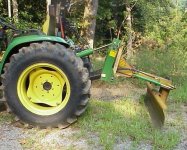</font><font color="blue" class="small">( Mine will, on
bx2200, I don't understand all the concern for the wear on the pins, it ain't like we are using 200hp tractors and all the pins are hardened, how long would it take to wear the pins, ten years use???? and they're replaceable. )</font>
It's not wear, it's binding. When you tilt the 3pt from left to right, the pins need to angle. A ball will do so - that is the design of the ball.
Pat's locks the ball solid, and does not have a ball of it's own.
If you use tilt with a regular 3pt quick hitch, the balls of your tractor are still operational - all will be fine.
With Pat's system, the pins must be cock-eyed in Pat's latch mechinism.
This could bend or break the pins or Pat's latches. Angling the pins in Pat's hooks may apply too much force to the top of the hook, rather than the strongest bottom of the hook as intended? Applying angle forces to things not designed for them can be a bad thing.
So, the question is, can Pat's system take the movement of the tilt function of a top & tilt? (It very well may, and it seems to be a pretty handy system for many things...)
The first time I saw Pat's system was at my dealer several years ago. That was for a cat 2 hitch. My tractors go to 140hp, and yes I for one am concerned about applying that much power to angled, stressed pins, and long-term wear. I may not be the typical interested party here, but we shouldn't forget about the long reach of the internet, and who all is lurking & trying to learn from this forum.
You see, a typical use of this much power & a top & tilt is for a fork lift to handle round bales, heavy farm equipment, & large bulk-sacks of seed. These are heavy loads (2 tons plus) which people typically end up standing near or under - even tho we shouldn't. I just bought a quick hitch which my 15 row bean planter hangs on - that's 3000lbs empty, 4000lbs full, and boucing around the fields I wonder what the shock load is?
So, I would not dismiss the question so quickly, even tho the question does not apply directly to a small CUT. There are many readers out here.
--->Paul


